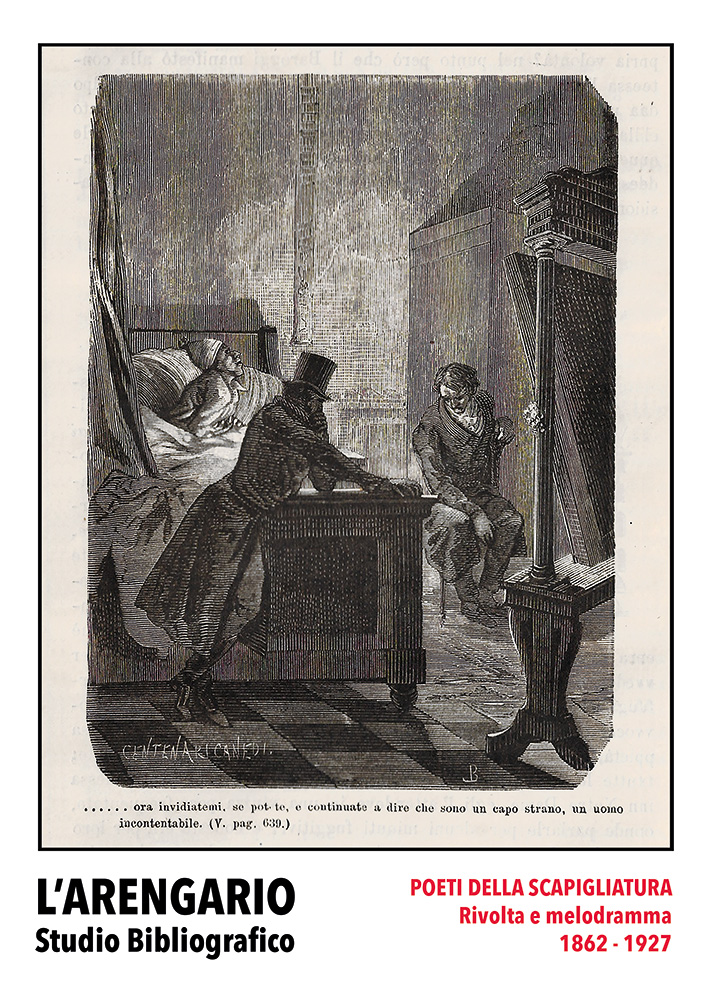L'ARENGARIO STUDIO BIBLIOGRAFICO - Dott. Paolo Tonini
Poeti della Scapigliatura. Rivolta e melodramma
Luogo: Cellatica
Editore: L'Arengario Studio Bibliografico
Stampatore: prodotto in proprio
Anno: 2024 (17 novembre)
Legatura: brossura
Dimensioni: 29,7x21 cm.
Pagine: pp. X - 48 (2) compresa la copertina
Descrizione: copertina illustrata con una incisione tratta dal libro di Giuseppe Rovani «Cento anni» (Milano, Redaelli, 1868-1869). Catalogo illustrato a colori, 48 schede ragionate, a cura e con introduzione di Paolo Tonini («Bohème arte vita» / «Bohemia Art Life»). Edizione digitale.
Bibliografia: N. D.
Prezzo: N. D.ORDINA / ORDER
La riflessione sull’esperienza della Comune era ben presente nella “bohème lombarda, scarlatta in politica ed atea in filosofia”: era vivo il sentimento di una rivoluzione mancata e il disgusto per il conformismo liberale. La Comune aveva materializzato le idee di rivolta nella pratica della democrazia diretta: e la reazione della borghesia spaventata era stata la repressione più brutale. La "bohème", espressione dell’energia e dell’entusiasmo giovanile, si accompagna alla disperazione di una generazione “perduta” come la definisce Felice Cameroni: questo “dualismo” messo in poesia, per esempio, da Arrigo Boito ed Emilio Praga, non è semplicemente l’effetto letterario di un dissidio interiore ma una dolorosa presa di coscienza: che la condizione di sopravvivenza per ciascun individuo sia l’adesione all’ordine costituito e che la funzione del lavoro intellettuale, attraverso le arti, le scienze, la politica, sia quella di trasmetterne il sistema di valori, la visione del mondo in cui si riconosce la classe dominante... (dal testo introduttivo).
Reflections on the experience of the Commune were very much alive within the “Lombard bohemia, scarlet in politics and atheist in philosophy”: the feeling of a missed revolution and the disgust for liberal conformism were palpable. The Commune had brought the ideas of rebellion into the practice of direct democracy, and the terrified bourgeoisie’s response had been brutal repression. The bohemia, as an expression of youthful energy and enthusiasm, was paired with the despair of a “lost” generation, as Felice Cameroni describes it. This “dualism” - poetically expressed by figures like Arrigo Boito and Emilio Praga - was not merely a literary effect of inner conflict but a painful awakening to the realization that individual survival required submission to the established order, and that the function of intellectual labor through the arts, sciences, and politics was to transmit the values and worldview of the ruling class...
DOWNLOAD PDF FILE
Reflections on the experience of the Commune were very much alive within the “Lombard bohemia, scarlet in politics and atheist in philosophy”: the feeling of a missed revolution and the disgust for liberal conformism were palpable. The Commune had brought the ideas of rebellion into the practice of direct democracy, and the terrified bourgeoisie’s response had been brutal repression. The bohemia, as an expression of youthful energy and enthusiasm, was paired with the despair of a “lost” generation, as Felice Cameroni describes it. This “dualism” - poetically expressed by figures like Arrigo Boito and Emilio Praga - was not merely a literary effect of inner conflict but a painful awakening to the realization that individual survival required submission to the established order, and that the function of intellectual labor through the arts, sciences, and politics was to transmit the values and worldview of the ruling class...
DOWNLOAD PDF FILE

